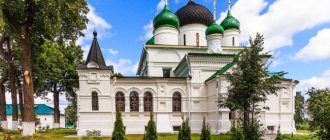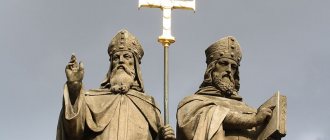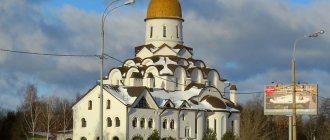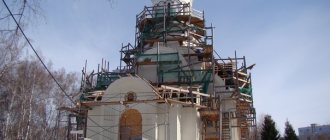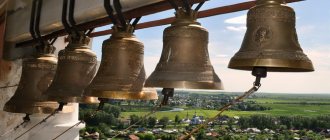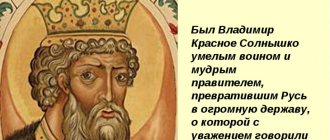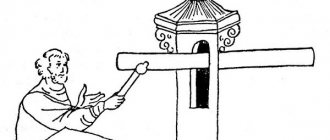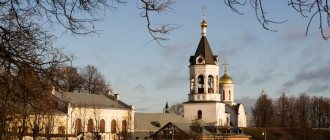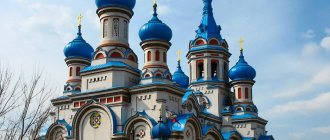- Reports
- Different
- Temples of Russia
Like any religion, Christianity has special places where believers can gather together, perform services, pray, and perform rituals accepted by the religion. The temple is, first of all, a cultural building that began to be erected in Rus' after the baptism, performed in 988 by order of Prince Vladimir.
Thanks to this, the style of Russian temple architecture appeared. This is the style of construction and decoration of Russian churches. At the moment, there are a large number of churches in Russia, each of which is unique and beautiful in its own way. The names of the temples are dedicated to some event designated in the Bible or holy scripture as a great good or to an Orthodox saint or icon, thanks to which the temple or cathedral was built. Let's look at a few examples:
Assumption Cathedral in the city of Vladimir. This is a white stone temple, preserved from the time of the Tatar-Mongol yoke. It has a bell tower and three golden domes.
St. Basil's Cathedral in Moscow. The cathedral is located in the very center of Moscow and was built by order of Ivan 4 (the Terrible). And the honor of taking many cities by the king. At the moment, the temple is a symbol of the city and Russia as a whole. Its baths are not covered with gold, like many other temples in the country, but are made in the shape of an onion and painted in two colors each. Moreover, not a single dome in the temple is repeated. There are legends about the construction of the temple, because the architects changed several times.
The Church of the Intercession on the Nerl appears as a classic version of a 10th century temple. It was built in 1165 on the banks of the Nerl River. There are no bright or pretentious details in the design of the temple. Its walls are whitewashed, and the dome is dark gray. From its appearance it is immediately clear that people came to this place to pray and rest their souls. This temple blends perfectly with the surrounding nature.
Russian churches are capable of surprising with their beauty and scale. But with a wide variety of architectural buildings of Orthodox Christians, they all carry a single goal - to find a place to display love and gratitude to God, as well as to carry out prayers and rituals.
Message 2
The temple as the center of church existence appeared a long time ago. It was the beauty and wealth of the temple, where Prince Vladimir came, choosing his faith, that served as the impetus. The prince really liked the service itself, the grandeur and pomp.
After the Baptism of Rus, the very next year they began to build the first church in Kyiv. By order of Prince Vladimir, she was named “The Most Holy Theotokos.” Already in those days it was customary to donate whatever you could to churches. Therefore, to set an example, the prince donates “tithe” to the church, since then it is sometimes called the “Tithe Church.” Unfortunately, the church was destroyed by the Mongol-Tatars, and it stood there until the nineteenth century. The Church of the Assumption of the Blessed Virgin Mary was not just the first church erected in Rus', it also served as an example of architectural construction for other churches and monasteries that were subsequently built.
Since then, building temples has been a matter of honor and priority. The first thing that appeared at the site of the future settlement was the Temple. It was always built in a prominent place. Thanks to the reverent attitude towards temple construction, many temple monuments appeared. These are real masterpieces of architectural art.
Later, the Burning Bush Church appeared in Dyadkovo. There is no such second temple. The fact is that the iconostasis is made entirely of crystal. And although it was destroyed during the revolutionary years, they tried to restore it in the 90s.
The temples of Arkhyz are considered ancient and unique. The first baptismal shrine was also discovered in the northern Caucasus.
The oldest churches are those built before the Mongol-Tatar invasion. In the Vladimir region, the Church of the Intercession on the Nerl, and the Cathedral of the Nativity of the Virgin Mary of the Holy Bogolyubsky Monastery, this is where Andrei Bogolyubsky was killed. In the city of Vladimir there is the Assumption Cathedral, and it is famous for the fact that it contains frescoes that Rublev himself painted. Demetrius Cathedral, erected in the 12th century in honor of the Great Martyr Demetrius of Thessalonica.
These are not all ancient temples, there are many of them in Rus', unfortunately, not all have survived to this day. Many had to be restored according to drawings and sketches. I can talk about temples for a long time. The Russian people sincerely revere the saints and great martyrs. People visit churches not only to pray and admire the beauty of Orthodox churches, but also to thank the saints for their help.
4, 5, 6, 8 grade
LiveInternetLiveInternet
Quote from message in the evening
Read in full In your quotation book or community!
Temples of Russia - photographs and brief description
A selection of Russian heritage, the most beautiful churches of the Russian Federation
Cathedral of the Nativity of the Blessed Virgin Mary, Rostov-on-Don.
The temple was built according to the standard design of the architect K. A. Ton and is externally very similar to his other temples built according to his designs: the Cathedral of Christ the Savior in Moscow and the Vvedensky Church of the Semenov Regiment in St. Petersburg and the Holy Spirit Cathedral in Petrozavodsk, which have not survived to this day. But to say that one is a copy of the other is wrong.
In addition, in 1887, according to the design of the military architect-engineer A. A. Campioni and the artist-architect D. V. Lebedev, on its western side, a four-tier bell tower was erected with the Church of St. Nicholas the Wonderworker, Archbishop of Myra in Lycia and a belfry, height 75 meters. The gospel of its 10-ton bell can be heard 42 versts along the Zadon region.
Kazan Cathedral in St. Petersburg, the temple of military glory, one of the most magnificent temple buildings in St. Petersburg.
The main façade of the cathedral faces Nevsky Prospekt and forms the unique appearance of the city's main thoroughfare. The temple building, conceived by the architect A.N. Voronikhin, bears the features of European classical architecture, in particular, St. Peter's Cathedral in Rome, and at the same time, the Russian architectural style with elements of eclecticism and classicism is clearly visible here. The cathedral amazes with its gigantic, slightly curving colonnade, which consists of 96 thirteen-meter columns of the Corinthian order. These huge columns are made from blocks of stone brought from special quarries in Gatchina, a suburb of St. Petersburg. And in the external design of the cathedral there are picturesque reliefs and statues.
Cathedral of Christ the Savior in Moscow
The most famous and most important cathedral in the country.
It was recreated in the 1990s on the site of the temple of the same name, created in the 19th century. The temple, 105 meters high, was built in the Russian-Byzantine style. The domes of the cathedral are made of stainless steel and covered with a thin layer of gold, and were also coated with a layer of diamond dust to protect them from atmospheric agents. The temple has 12 external doors cast in bronze. Numerous figures of saints are placed in the arches and niches of the temple. Currently, the temple has the status of a metochion of the Patriarch of Moscow and All Rus'.
Epiphany Cathedral in Elokhov (Moscow)
It was built in 1837 according to the design of the architect E.D. Tyurin. The building was built in the style of classicism and is crowned with five domes on light drums, which form the main decoration of the temple. The large central rotunda has tall semicircular windows with graceful paintings on top, separated by paired columns. The temple is crowned by a huge golden dome with a small dome at the top. The side entrances to the temple are very large, divided into three parts by columns; There are semicircular windows on top. The shoots are framed by wide paired pilasters. In 1930, the temple became the patriarchal cathedral. The Epiphany Cathedral is the heart of the spiritual life of Orthodox Russia over the last 60 years. It never closed.
Resurrection Cathedral of the New Jerusalem Monastery (Istra)
A unique temple structure, both in complexity and beauty, built in 1658-1685.
The cathedral was conceived as a copy of the Church of the Holy Sepulcher in Jerusalem, but during construction it was not an exact repetition of the prototype, but rather its artistic transformation. The cathedral consists of several parts: in the center is the four-pillar Church of the Resurrection, to the west of it is a rotunda covered with a high tent with the Chapel of the Holy Sepulcher, to the east is the underground church of St. Constantine and Helena, as well as surviving fragments of the bell tower.
Assumption Cathedral in Vladimir
Cathedral Orthodox Church of the Vladimir Diocese on Cathedral Square in the city of Vladimir.
The Assumption Cathedral is the most beautiful architectural structure of Ancient Rus', a unique monument of the Vladimir-Suzdal white stone architecture of the pre-Mongol era. Following his model, the Italian architect Aristotle Fioravanti built the Assumption Cathedral of the Moscow Kremlin. The Assumption Cathedral houses examples of art by the best artists of different times, from nameless isographers of the mid-12th century to the brilliant Andrei Rublev and masters of the 17th and 18th centuries.
Annunciation Cathedral of the Kazan Kremlin (Kazan)
It is one of the oldest and most interesting monuments of Russian church architecture.
The foundation of a wooden church on the site of the future cathedral is traced back to the acts of Tsar Ivan the Terrible. The cathedral belongs to the Pskov school of Russian architecture. During this period, masters Postnik Yakovlev and Ivan Shirai were instructed to go to Kazan to build a new stone city (Kremlin). The domes of the cathedral were originally semicircular in shape, but were redone in 1736. Four domes became onion-shaped; the middle dome of the cathedral was built in the Ukrainian Baroque style, covered with copper and gilded. Annunciation Cathedral in the Kazan Kremlin It remains the most ancient building in the Kremlin ensemble.
St. Sophia Cathedral in Veliky Novgorod
A wonderful architectural monument that has absorbed not only the features of Russian, but also foreign architecture.
Thus, the western entrance of the St. Sophia Cathedral is decorated with the famous Maglebur Gate of the 12th century. Tradition says that this is a military trophy obtained by the Novgorodians during the capture of the Swedish capital of Sigtuna in 1187. There is also the Korsun Gate of the 11th century, Byzantine work, leading to the Nativity border. During the Great Patriotic War, the cathedral was destroyed, but retained its shape. At present it is almost the same as it was in the 11th century. This is a five-nave cross-domed church with three apses.
St. Nicholas Naval Cathedral in St. Petersburg
A beautiful temple in the Elizabethan Baroque style, located on Nikolskaya Square.
It was built in the period from 1753 to 1762 (architect S.I. Chevakinsky) on the naval regimental yard on the site of a wooden church, and can accommodate about five thousand people. Next to the cathedral there is a four-tiered bell tower topped with a high spire. The majestic building of the St. Nicholas Naval Cathedral is decorated with Corinthian columns gathered in bunches, stucco platbands, a wide entablature and crowned with a gilded five-domed dome. The rich plasticity of the facade is complemented by balconies with patterned forged grilles. During the consecration, the cathedral was named naval, since the victories of the Russian fleet were celebrated there.
The Vladimir Cathedral in St. Petersburg is dedicated to the Vladimir Icon of the Mother of God, one of the most revered icons in Rus'.
This five-domed temple is an architectural monument of the transitional style from Baroque to Classicism, and includes two churches - upper and lower. Currently, services are held only in the upper church. The sails of the central dome are decorated with sculptural images of the evangelists.
Spaso-Preobrazhensky Cathedral of the Solovetsky Monastery
A majestic two-pillar temple, more than 40 meters high, which has no analogues in medieval Rus'
It is crowned with five chapters. The drum under the central head is shifted to the east and is perceived as a tent. The high vaults of the temple rest on two massive pillars, the light falls from above from the tent-drum, which seems to float above the iconostasis. The history of the main temple of the Spaso-Preobrazhensky Solovetsky stauropegial monastery goes back almost six centuries. The holy relics of the first founders of Solovetsky - the Venerables Zosima and Savvaty - are kept here.
Cathedral of the Assumption of the Blessed Virgin Mary
The largest Orthodox church in Astrakhan. Located on the territory of the Astrakhan Kremlin.
Built in 1699-1710, it is considered one of the best examples of Russian church architecture of the early 18th century, and is the only architectural temple complex preserved in Russia, where the temple and the Execution Place are connected.
Annunciation Cathedral, located in the center of Voronezh.
Built according to the design of architect V.P. Shevelev in the Russian-Byzantine style. The cathedral is located on Revolution Avenue on the territory of the Pervomaisky Garden. The height of the temple itself is 85 meters, and its highest point is 97 meters. It is the third largest Orthodox church in Russia and one of the tallest Orthodox churches in the world. Construction took place from 1998 to 2009.
Holy Trinity Cathedral in the city of Murom, on the left bank of the Oka River.
Erected in 1643. The main decoration of the Holy Trinity Cathedral are forged gilded crosses - masterpieces of blacksmith work by Murom craftsmen of the 17th century - and glazed tiles of the same century with various ornaments. The tiles give the Trinity Cathedral a special grace and unique identity that distinguishes it from other Murom churches.
Smolny Resurrection of Christ
The cathedral is part of the architectural ensemble of the Smolny Monastery, which is located in St. Petersburg on the left bank of the Neva on Smolnaya Embankment.
In the 1730s, the heir to the royal throne, Elizaveta Petrovna, decided to spend the last years of her life in the peace and quiet of the monastery, surrounded by one hundred and twenty noble maidens. Already being an empress, she ordered the construction of a monastery on the site of the Smolny House, the palace in which she lived her youth. The monastery complex was to include a temple with house churches and a bell tower and an institute for girls from noble families. The architect of the cathedral is F. B. Rastrelli.
Trinity-Izmailovsky Cathedral on Trinity Square in the Admiralteysky district of St. Petersburg.
Full name - Cathedral of the Holy Life-Giving Trinity of the Life Guards Izmailovsky Regiment. The stone cathedral, cruciform in plan, is crowned with a powerful five-domed dome. The temple was built in the Empire style. At the time of its consecration, the cathedral was the largest in Russia. The domes are painted with gold stars on a blue background according to the personal instructions of Nicholas I, given in 1826: the domes should be painted like the domes of the Archangel Cathedral in Moscow and Tver Cathedral in Tver. The facades of the cathedral are decorated with six-column porticoes of the Corinthian order with a sculptural frieze. In the niches of the porticos there are bronze figures of angels.
Cathedral of the Resurrection of Christ on Spilled Blood, Church of the Savior on Spilled Blood in St. Petersburg
The Orthodox memorial single-altar church in the name of the Resurrection of Christ was built in memory of the fact that at this place on March 1, 1881, Emperor Alexander II was mortally wounded as a result of an assassination attempt (the expression on the blood indicates the blood of the king). The temple was built as a monument to the Tsar-Martyr with funds raised throughout Russia; the project was made in the “Russian style”, somewhat reminiscent of Moscow's St. Basil's Cathedral.
Cathedral of the Intercession of the Blessed Virgin Mary on the Moat, also called St. Basil's Cathedral
An Orthodox church located on Red Square in Kitay-Gorod in Moscow.
A widely known monument of Russian architecture. Until the 17th century, it was usually called Trinity, since the original wooden church was dedicated to the Holy Trinity; was also known as “Jerusalem”, which is associated both with the dedication of one of the chapels and with the procession of the cross to it from the Assumption Cathedral on Palm Sunday with the “procession on the donkey” of the Patriarch.
Currently, the Intercession Cathedral is a branch of the State Historical Museum. Included in the List of UNESCO World Heritage Sites in Russia.
According to legend, the architect(s) of the cathedral were blinded by order of Ivan the Terrible so that they could not build another similar temple.
There are only 10 domes. Nine domes over the temple (According to the number of thrones: the Intercession of the Virgin Mary (central), Holy Trinity (eastern), Entrance to Jerusalem (western), Gregory of Armenia (north-western), Alexander of Svirsky (south) -east), Barlaam of Khutyn (south-west), John the Merciful (formerly John, Paul and Alexander of Constantinople) (north-east), Nicholas the Wonderworker of Velikoretsky (south), Adrian and Natalia (formerly Cyprian and Justina) (northern)) plus one dome over the bell tower.
Holy Trinity Cathedral
An Orthodox church, which is part of the architectural ensemble of the Pskov region and is its main building.
The site for the construction of the temple, which was to become the center of the settlement, was chosen by Grand Duchess Olga, who was born here, when she visited the Pskov land in 957. As the chronicle says, when she stood on the bank of the river, a vision appeared to her in the form of three rays pointing to this place - that is why they decided to dedicate the temple to the Life-Giving Trinity.
Military Resurrection Cathedral, Starocherkassk city.
Near the temple there is a two-tier tented bell tower 45.8 meters high. This is the only building of this type in Southern Russia.
Ascension Military Cathedral, Novocherkassk
Laid down in 1805. Its construction began in 1811, while we note that the larger St. Isaac's Cathedral in St. Petersburg will begin to be built in 1818, and the Cathedral of Christ the Savior in Moscow even later in 1832.
The seventh highest domed cathedral building in Russia after the Cathedral of Christ the Savior, St. Isaac's Cathedral, Smolny Resurrection Cathedral in St. Petersburg, Trinity-Izmailovsky Cathedral in St. Petersburg, Church of the Savior on Spilled Blood in St. Petersburg, Trinity Cathedral in Pskov.
Church of the Ascension of the Lord in Kolomenskoye
Orthodox Church of the Danilovsky Deanery of the Moscow Diocese.
The temple is located in the Nagatinsky Zaton area, the Southern administrative district of Moscow, in the former village of Kolomenskoye near Moscow. The temple is a masterpiece of world architecture, the first stone tented temple in Russia.
Sunday, February 20, 2022, about the prodigal son
Sunday is a day off, which every Christian devotes to God and His works, first of all, to visiting church. On this day we put aside other things to participate in the liturgy.
In the “Getting Ready for Sunday” project, we are trying to help you consciously come to Church, study the traditions and features of worship in advance, get acquainted with a passage from Holy Scripture and its interpretations, as well as the short lives of the saints commemorated by the Church on Prodigal Son Sunday - February 20 .
Kontakion of the Week about the Prodigal Son
Thy fatherly glory has gone madly away,/ having squandered it on the wicked, thou hast given up wealth unto me./ Moreover, I offer thee the voice of the prodigal:/ those who have sinned before Thee, generous Father,/ receive me repentant,// and make me as one of Thy hired servants.
more about the prodigal son in our materials:
The Week of the Prodigal Son - the second preparatory week of Lent
About the lost: care, love, mercy. Article by Marina Andreevna Zhurinskaya (06/26/1941 - 10/4/2013)
“The Return of the Prodigal Son” - why does Rembrandt’s painting leave no one indifferent?
Church of the Savior on Spilled Blood (1907)
A kind of monument to the deceased king.
The history of the appearance of this temple is marked by a tragic event for the Russian Empire. After all, it was built on the site where Alexander II was killed. The author of this architectural project was Alfred Parlanda, and he was personally chosen by the son of the deceased ruler, Alexander III.
Not only the architecture, but also the history of its creation is of interest.
The process of building this structure is also interesting. For example, funds for construction were collected literally all over Russia. And the mosaics planned for it turned out to be so complex and large-scale that construction work dragged on for ten years. In addition, the Church of the Savior on Spilled Blood is the first domestic religious building to be fully electrified.
Interior design and architecture
The architecture of Orthodox churches in the era of Ancient Rus' was based on the cross-dome system. The history of the construction of durable monumental cross-domed churches made of stone dates back to the construction of the Tithe Church in Kyiv, the construction of which lasted seven years (from 989 to 996).
Tithe Church in Kyiv
Initially, the technology for building stone churches and the typology of their architecture was borrowed by ancient Russian architects from Byzantine traditional canons. In addition, after an important historical event - the Baptism of Rus', the first churches were built by craftsmen invited from Byzantium.
Such buildings can safely be called outstanding examples of Byzantine architectural style, but from the very beginning these Christian religious buildings began to show their own original features. Their appearance was due to the peculiarities of local conditions and the wishes of customers.
A year after the baptism of Rus' in 988, construction began on the Church of the Tithes, which was first built of wood. Subsequently, this pearl of ancient Russian architecture was destroyed during the invasion of Batu Khan.
During the reign of the great Kyiv prince Yaroslav the Wise, large-scale construction of Christian churches began. It was during this era that the St. Sophia Cathedral was built, the size of which had no equal not only in Rus', but also in Byzantium itself.
Since ancient times, Kyiv has been called the mother of Russian cities. The official date of birth of the city is considered to be 1037, although the first settlements appeared on the banks of the Dnieper five centuries earlier.
After the victory of the Russians over the Pechenegs during the reign of Yaroslav the Wise, Kyiv acquired the significance of the main city of the Old Russian state. And this primacy is consolidated by the construction of the St. Sophia Cathedral, which was built in 1037 - 1044.
Sophia of Kiev served as the main temple of all Ancient Rus', whose population had just been baptized. Therefore, the grandiose dimensions and beauty of the structure should have shocked the imagination and delighted everyone who saw the St. Sophia Cathedral.
St. Sophia Cathedral in Kyiv
The thirteen-domed, five-nave cross-domed church was distinguished by its massiveness and heaviness of forms, giving it solemnity and significance. The exterior of the cathedral is unique - simple brickwork without plaster emphasizes the severity and grandeur of the structure.
The interior decoration was rich and skillfully executed by the best craftsmen of their time. From the inside, all the walls and vaults of the temple were covered with colorful frescoes and mosaics on Christian themes.
Maria Oranta - mosaic of St. Sophia Cathedral.
The cathedral served not only as a cult building, but also as the main public building of Ancient Rus'. Here they received foreign ambassadors and gave the right to reign to the Novgorod, Suzdal and Rostov princes.
In the model and likeness of Sophia of Kiev, the second example of ancient Russian cross-domed architecture was built - the St. Sophia Cathedral in Novgorod (1045 - 1050). However, the temple had significant differences. It was made of unprocessed stones that retained their natural shape. The stones were fastened together with lime mortar.
Subsequently, the walls were whitewashed with plaster, which, in combination with the golden domes, made the building even more picturesque.
St. Sophia Cathedral in Veliky Novgorod
The Novgorod St. Sophia Cathedral breathes with heroic strength. This temple served as the main shrine of the Novgorod Republic. Novgorodians were very proud of their Sofia, they revered the cathedral and said: “Where Sofia is, there is Novgorod.”
In the 12th century, St. Sophia Cathedral became a symbol of the Novgorod principality, independent from Kyiv and other cities. Novgorod had its own elected government - the veche. The veche bell of the St. Sophia Cathedral called people to veche meetings. Subsequently, Novgorod submitted to the Moscow prince Ivan III, and the veche bell was removed and taken to Moscow.
In 1066, the third temple was built - the seven-domed, five-nave St. Sophia Cathedral in Polotsk . The construction of three temples of the same type on the territory of present-day Russia, Ukraine and Belarus was an indicator of the political and cultural unity of the three main parts of the ancient Russian state.
Polotsk Sofia
In the 12th century, the most powerful in Rus' was Vladimir - the Suzdal principality. Its rulers, the princes, trying to consolidate their power, built majestic palaces and temples that were supposed to preserve their glory for centuries.
Mother of God - Nativity Cathedral, built in the 11th century (Suzdal).
The founder of the city of Vladimir in 1108 was the grandson of the Kyiv prince Yaroslav the Wise, Vladimir Monomakh. His father’s work was continued by his son and successor Yuri Dolgoruky, who was so nicknamed for his desire to expand the territory of his principality and subjugate Kyiv.
During the reign of Yuri, the most significant cities of the Vladimir-Suzdal land were founded: Yuryev-Polsky, Zvenigorod, Moscow, Dmitrov, Pereyaslavl-Zalessky. Today, all of them are cities - monuments that constitute the glory and pride of the masters of ancient Russian architecture.
The Vladimir-Suzdal principality reached its greatest prosperity during the reign of Andrei Bogolyubsky, the son of Yuri Dolgoruky. In less than 20 years of his reign, Andrei initiated the construction of many beautiful architectural structures, which we continue to admire today.
According to data from chronicle sources, in the period from 1158 to 1164 the Golden Gate was built in Vladimir, as well as the golden-domed Assumption Cathedral , which became a symbol of the wealth and power of the powerful Prince Andrei.
Assumption Cathedral in Vladimir
The small and elegant Church of the Intercession on the Nerl became a real masterpiece. It was built by Prince Bogolyubsky in honor of his deceased son. The refined forms of the temple evoke admiration for the art of the architects of Ancient Rus'.
Church of the Intercession on the Nerl
Construction technology
The main building material of the Vladimir-Suzdal land was white stone. Blocks measuring 50 by 50 cm were cut out of it. The walls of the temples were laid out from two rows of such blocks, and the space between them was filled with rubble and filled with a binding solution.
This method of constructing walls made it possible not only to give the masonry additional strength, but also to use a smaller amount of white stone, which was considered a scarce material due to the difficulty of extraction. Today there is very little white stone left.
Stone carving
White stone lends itself well to processing. The architects of Ancient Rus' used this quality of material to decorate the facades of their buildings. Stone carving in the 12th - 13th centuries was a very popular technique for decorating the walls of temples.
A striking example of carved stone decor is the Dmitrievsky Cathedral in Vladimir , built in 1194 - 1197. Its walls are covered with continuous carved stone relief. The most complex patterns are a symbol of the richness and diversity of the world, inhabited by strange animals and fabulous birds sitting on the branches of unprecedented plants.
Demetrius Cathedral in Vladimir
Temple decor
An integral part of the decoration of Russian churches were icons - picturesque images of saints. The most revered icon was the icon of the Mother of God with a baby in her arms. The icon of the Vladimir Mother of God , painted in the 11th - 12th centuries, is rightfully considered one of the most perfect works of world art
Icon of the Vladimir Mother of God
Icons, frescoes and mosaics made by famous artists in many other churches are also of great artistic value. Among them are frescoes by Dionysius, icons by Andrei Rublev, ceramic tiles by Stepan Polubes. The most significant works of these great masters today are kept in the Tretyakov Gallery and other museums.
Frescoes of Dionysius in the Ferapontov Monastery
The tiles on the walls of the temple are the creation of Stepan Polubes.
Assumption Cathedral in Moscow (1479)
Another iconic pearl of the capital.
The Moscow Assumption Cathedral is interesting primarily because it is the oldest building in the capital, which has preserved its original appearance. The first stone of the building was laid back in 1472, and the building itself was erected according to the design of two Pskov masters - Myshkin and Krivtsov. However, in 1474, the almost completed structure collapsed, and then the Italian Aristotle Fioravanti was brought in to complete the work.
Vaults that are more than five hundred years old.
Surprisingly, after the change of architect, construction did not slow down. Already in 1479, the cathedral was consecrated; painting and interior decoration took less than three years. Of course, throughout its long history the building has been restored several times, but it has not lost any of its originality and authenticity.
Christian churches. Completed Reviews Gera 5th grade. - presentation
Christian churches. Completed Reviews Gera 5th grade.
Orthodox church. A temple in Orthodoxy is an Orthodox liturgical religious building that has an altar, a throne, and a dome. A temple in Orthodoxy is an Orthodox liturgical religious building that has an altar, a throne, and a dome.
Scheme of an Orthodox church.
Symbol and device. Traditionally, Christian churches have a cross in their plan - a symbol of the cross of Christ as the basis of eternal salvation, a circle (rotunda type of temple) - a symbol of eternity, a square (quadrangle) - a symbol of the earth, where peoples converge in the temple from four directions of the world, or an octagon (octagon on a quadrangle) ) - symbol of the guiding star of Bethlehem. Each temple is dedicated to some Christian holiday or saint, whose memorial day is called a temple (throne) holiday. Sometimes several altars (chapels) are arranged in the temple. Then each of them is dedicated to its own saint or event. Traditionally, Christian churches have a cross in their plan - a symbol of the cross of Christ as the basis of eternal salvation, a circle (rotunda type of temple) - a symbol of eternity, a square (quadrangle) - a symbol of the earth, where peoples converge in the temple from four directions of the world, or an octagon (octagon on a quadrangle) ) - symbol of the guiding star of Bethlehem. Each temple is dedicated to some Christian holiday or saint, whose memorial day is called a temple (throne) holiday. Sometimes several altars (chapels) are arranged in the temple. Then each of them is dedicated to its own saint or event.
Altar. The altar is the place of the mysterious presence of the Lord God, and is the main part of the temple. The most important place in the altar is a throne in the shape of a quadrangular table, it has two clothes: a lower one made of white linen and an upper one. The altar is the place of the mysterious presence of the Lord God, and is the main part of the temple. The most important place in the altar is a throne in the shape of a quadrangular table, it has two clothes: a lower one made of white linen and an upper one.
The main temple of our country. Who is this, in the golden helmet of a giant, visible throughout Moscow, shining with radiance from everywhere, visible for many miles, from all ends? The sound of the great Temple is wonderful: there is a lot of silver in it, and its copper is melodious in a special way: dull, soft, as if the earth were calling. The Temple is made of soft stone, sandy, light. Its walls are all ours: the memory of Russia gathering its military forces. Alexander Nevsky, Dmitry Donskoy, Vladimir, Olga. What a distance! Carved in stone over centuries" Who is this, in the golden helmet of a giant, visible throughout Moscow, shining with radiance from everywhere, visible for many miles, from all ends? The sound of the great Temple is wonderful: there is a lot of silver in it, and its copper is melodious in a special way: dull, soft, as if the earth were calling. The Temple is made of soft stone, sandy, light. Its walls are all ours: the memory of Russia gathering its military forces. Alexander Nevsky, Dmitry Donskoy, Vladimir, Olga. What a distance! Carved in stone over centuries"
Main temple.
The main temple of the Khabarovsk Territory. The golden-domed cathedral with five domes is located on the steep bank of the Amur. The height of its domes reaches 83 meters, with crosses - 95 meters, which makes the cathedral a dominant feature in the panorama of the city. The cathedral can simultaneously accommodate three thousand people. The upper main temple is consecrated in honor of the Transfiguration of the Lord, and the temple on the lower floor is in the name of the Apostle and Evangelist Mark. The golden-domed cathedral with five domes is located on the steep bank of the Amur. The height of its domes reaches 83 meters, with crosses - 95 meters, which makes the cathedral a dominant feature in the panorama of the city. The cathedral can simultaneously accommodate three thousand people. The upper main temple is consecrated in honor of the Transfiguration of the Lord, and the temple on the lower floor is in the name of the Apostle and Evangelist Mark.
The main temple of our region.
Christian churches.
Popular message topics
- Chemical industry
It can be said that the chemical industry is engaged in changing the chemical structure of natural materials, subsequently obtaining very valuable products intended for use in other industries. - South America
The continent of South America is located in the Western Hemisphere of the Earth along with its neighbor North America. These two continents are connected by the Panama Canal. South America, although it lies very close to North America, - Nonmetals
Nonmetals are special chemical elements. Until recently, these elements were called metalloids. They differ in that due to the small radius of the atom, as well as the presence of three or more negative
Message on art on the topic “Temples of Russia”
"Temples of Russia"
Temples of Russia
Stone Temple
Stone temple dating from the 10th century (before 1013). A three-nave, single-domed, three-apse church with slightly lowered corner compartments and small lowered vestibules. By the 19th century it was abandoned, during the creation of the monastery it was partially conserved, and in the 20th century it was restored. Presumably in the 10th-13th centuries the temple served as the cathedral of the Alan diocese.
During excavations in the 20th century, a baptismal chamber made of flat stone slabs was discovered. The rite of baptism, one of the main sacraments of Christianity, took place here. An extensive female burial was found near the southern wall of the temple, where jewelry was preserved, as well as a large lump of elderberry and galega grains, which indicates the remains of pagan rituals in a Christian burial inside the church.
Inside, the walls of the temple were covered with frescoes (not preserved). Some of them were sketched by D.M. Strukov. From these drawings it follows that the largest number of frescoes has been preserved on the northern walls and the drum. Some characteristic features indicate that the frescoes belong to the traditions of Byzantine church painting.
In the same area, ancient Russian folding encolpion crosses were found, which confirms the existence of trade and cultural ties between Alania and Kievan Rus.
Currently under the jurisdiction of the Nizhne-Arkhyz Historical and Archaeological Reserve. Divine services are held only once a year - on May 6, on the day of remembrance of one of the most revered saints in the North Caucasus - St. George the Victorious.
Church of St. John the Baptist in Kerch
The exact date of construction of the temple is unknown. Researchers believe that it was erected in the 10th century, and elements of an even more ancient cult building of the 6th century were used in its construction. These include Byzantine baked brick, carved blue-veined Greek marble columns and stone ceilings. Amphoras from the 8th century were discovered in the walls; they served as vocalists - they amplified sound and eliminated echo.
In the 13th–15th centuries, when Kerch became a Genoese colony, Italian frescoes appeared in the temple. Some of them perished during the Crimean Khanate: the authorities gave the building to a mosque, and the workers scraped and smeared the faces of the saints.
Construction of the temple began in the 19th century. In 1801, the western aisle was erected, and in 1845, a two-tier bell tower and a northern vestibule in the neo-Byzantine style. When they dug the foundation, they discovered funeral steles from the 5th century BC. e. The stones were built into the southern wall of the temple.
During Soviet times, the temple housed the Kerch Lapidarium, a collection of archaeological finds from ancient times. And today, services are held here again.
Cathedral of Sophia of the Wisdom of God in Novgorod
The St. Sophia Cathedral in Veliky Novgorod was founded by Prince Yaroslav the Wise on the site of the 13-domed temple in 989. It was consecrated by the first Russian bishop Luka Zhidyata in 1050.
The cathedral was built according to the type common in Ancient Rus' - cross-domed. The outline of its base resembled a cross, and the interior space consisted of a main volume under the dome and four galleries on different sides.
The inside of the temple was finished already in the next century. It was decorated in the manner of Byzantine cathedrals, only instead of marble and mosaics, plaster and frescoes were applied to the walls. At the end of the 12th century, bronze gates were installed in the cathedral, which were created by German craftsmen in Magdeburg. The doors were decorated with bas-reliefs based on scenes from the Old and New Testaments.
The cathedral preserves fragments of frescoes from the 12th century: images of prophets and angels on the arches of the main dome and wall faces of Saints Constantine and Helen. In the temple you can also see the royal prayer place, which was installed by order of Ivan the Terrible, and the chandelier - the main candelabra. It was presented to the cathedral by Boris Godunov.
Temple in the name of the Holy Apostles Peter and Paul in Smolensk (Peter and Paul Church)
Peter and Paul Church is the oldest in Smolensk. It was built in 1146 under Prince Rostislav Mstislavich, the grandson of Vladimir Monomakh. The inside of the temple was painted with frescoes with floral patterns. Later, the brick floor was covered with majolica tiles, and the walls were decorated with tiles and panels.
During the Time of Troubles, Smolensk was occupied by the Poles, and Catholic services were held in the Peter and Paul Church. It was then that the western extension appeared - the residence of the Polish bishop. The temple was returned to Orthodox parishioners in 1654, when the Poles left the city. The diocese erected a tented bell tower near the western wall.
In the 17th–18th centuries, the third floor was built in the temple, the main nave was expanded and the floor was raised to the level of the first floor of the extension. The church acquired its original appearance only in the middle of the last century.
Today in the Peter and Paul Church you can see fragments of medieval frescoes, ancient colored tiles, as well as rare graffiti - inscriptions from the 12th century.
Read more about the temple in the name of the Holy Apostles Peter and Paul in Smolensk (Peter and Paul Church).
Church of Boris and Gleb in the village of Kideksha
The Boris and Gleb Church in the village of Kideksha not far from Suzdal appeared during the time of Yuri Dolgoruky, in 1152. This is one of the first white stone buildings in North-Eastern Rus'.
Building a church in those days was almost as difficult as the Egyptian pyramids. The material was mined near Moscow, 500 km from these places, and transported along rivers and land. Workers trimmed cobblestones and laid them with virtually no mortar.
The appearance of the church combined features of Russian medieval architecture and Western Romanesque style: a traditional cubic base, an unusually designed portal and arcature - rows of decorative false arches on the walls. Throughout history, the temple was restored more than once, and in the 17th century the dome was replaced.
At the end of the twentieth century, the Boris and Gleb Church was included in the UNESCO World Heritage List. Nowadays, the temple is not in use; frescoes from the 12th century are being studied here and excavations are taking place. Under the modern floor, researchers discovered the original base of the iconostasis and omphalia - a place for the bishop - made of rare pink stone. Omphalius of the Boris and Gleb Church is the oldest in Russia.
Spaso-Preobrazhensky Cathedral of the Mirozh Monastery
The Transfiguration Cathedral was erected on the banks of the Velikaya River in Pskov by order of the Novgorod Archbishop Nifont. It was not possible to establish the exact date of construction, but it is known that in 1156 the temple already existed.
The building was built practically without a foundation; in some places the architects did not even bother to remove the top layer of soil and grass. The fact is that the coast is made of sandstone - a very mobile material that expands greatly in winter. The foundation could crack over time. Instead, the builders poured rubble stone, and strengthened the walls with a special mortar with lime. Therefore, the building did not collapse, despite the processes in the soil.
The temple was painted in the 30s of the 12th century by Greek masters. The frescoes were made with mineral paints and are similar to Byzantine icons. In the 17th century, the images were covered with plaster and whitewashed. By chance, this helped save about 80% of the drawings. Today, the paintings of the Transfiguration Cathedral are the most complete monument of medieval fresco painting in Russia.
Cathedral of the Assumption of the Blessed Virgin Mary in Vladimir
The white stone Assumption Cathedral was erected in 1160 by Grand Duke Andrei Bogolyubsky. The domes were covered with gilded copper sheets with prayer inscriptions, and the building itself was decorated with frescoes.
In 1185, after a fire, the temple was rebuilt by Prince Vsevolod the Big Nest. He added side galleries, and the old structure was inside the new one. The walls of the original cathedral were partially dismantled, leaving only the supports of the vaults.
In the 13th century, the cathedral suffered another fire - it was burned by the Mongol-Tatars. The temple was restored again, but painted much later, at the beginning of the 15th century. Andrei Rublev and Daniil Cherny came here for this purpose.
Throughout history, the temple was renovated and completed several times. The Baroque iconostasis, which can be seen in the cathedral today, was installed during restoration in the 18th century, at which time the four-tier bell tower appeared. Most of the Rublev frescoes were covered with plaster. Fragments of the composition “The Last Judgment” on the western wall and part of the frescoes in the altar room have survived to this day.
Today the cathedral is included in the UNESCO World Heritage List.
Fundamentals of Orthodox culture. Temple
Not everyone knows how an Orthodox church works. But every detail of the temple has a deep meaning and significance. The structure of an Orthodox church has its roots in deep, Old Testament antiquity. The Bible tells how God commanded Moses to build a tabernacle, that is, a sanctuary in the form of a tent, where the Lord promised to reveal himself to Moses. That is, the structure of the temple was determined by God the Father, it was the house of God, and everything inside was according to God’s plan.
The Tabernacle of Moses consisted of three parts, separated from each other by curtains: the outer part, intended for the people; behind it, the part into which the priests entered to make sacrifices was called “holy”; and then the third part, the “Holy of Holies,” which the high priests could only enter once a year.
The Tabernacle of Moses was the prototype of the modern temple. One of the most common architectural forms since ancient times was
basilica is a rectangular building, the internal space of which is divided by rows of columns or pillars into longitudinal parts - naves (from the Latin navis - “ship”), with the central nave being higher. The basilica represents the temple as a ship making its way through the stormy sea of life to the Kingdom of Heaven. To increase the internal space of the temple, in addition to the longitudinal ones, a special transverse nave was built. This basilica had a cross at its base.
Byzantine culture is characterized by cross-domed churches, which have a cross in plan and a large dome in the center.
The main parts of a Christian church are the vestibule - this is the western part of the temple. To enter it, you need to climb the steps to an elevated platform - the so-called porch, porch, area in front of the temple.
The narthex is a place where those who are preparing to be baptized, those who repent and those who have been excommunicated can be present; the middle (inner) part intended for worshipers; the altar is the most important place in the temple, symbolizing the Kingdom of Heaven. The altar always rises above the entire space of the temple, and that part of the elevation that is extended towards the people is called solea. The soleya ends with a round protrusion - the pulpit - a place for reading the Gospel and delivering a sermon by the priest.
Both the solea and the pulpit are a continuation of the altar. The fact that the altar does not end with the iconostasis means that for those praying in the church during the service, the same thing is done that is done in the altar. Believers approach the pulpit to receive communion. And along the edges of the solea there is a special fenced place for singers and readers, called the choir. The Greek word “clergy”, literally meaning “lot”, “allotment”, refers to the clergy, and the choir is a place for the church choir.
In an Orthodox church, sermons and prayers are conducted in the language of the country in which it is located. The Russian Orthodox Church prays in Yakut, Japanese, English, German, Moldavian, Chuvash, Mari and many other languages.
The only exception is the Russian language. Sermons are conducted in Russian, and services are conducted in Church Slavonic.
This is a very beautiful language, dear to the hearts of Orthodox parishioners. It was this language that retained the vocative case - Father, God, Virgin... It was the Church Slavonic language that taught Russian writers to compose two-root words: mercy, beneficence, good-heartedness... The Church Slavonic language is a common language for Orthodox Christians in many countries of the world - Russia, Bulgaria, Serbia, the Czech Republic...
The grammar rules for this language, as well as the alphabet for it, were created in the 9th century by the “enlighteners of the Slavs” - the holy brothers Cyril and Methodius - and their students.
An Orthodox temple is called a church. One of the distinctive features of the church is the iconostasis - a partition separating the main space of the temple from the altar, consisting of several rows of individual icons installed in a certain order.
The iconostasis separating the altar from the middle part is a feature of the Orthodox Church. On the one hand, it is a barrier between the main part of the temple and the altar, keeping secret what is happening in the Holy of Holies. On the other hand, the icons on it encourage believers to pray. In the center of the iconostasis are the Royal Doors, so called because during the service the Lord, the King of Glory, invisibly enters them.
He enters just as the Lord entered Jerusalem, “coming to free suffering.” Usually the “Last Supper” icon is located above the Royal Doors, because it is in memory of it that the sacrament of the Eucharist is celebrated in the altar. In addition to the Royal Doors, the altar has so-called side or deacon doors, through which deacons enter, ministers who help the priest perform divine services. The royal doors and the throne are separated by a special curtain. During services it opens and closes. The veil can be of different colors depending on the holiday. In the Old Testament temple, a curtain separated the Holy of Holies from the temple. During the death of the Savior on the cross, the veil of the Jerusalem Temple was torn in two as a sign that heaven was now open to all who follow Christ.
In large cathedrals, as a rule, the iconostasis consists of five tiers, or five rows of icons. These tiers are connected into a single whole.
The lower tier, or row, is called local because it contains a local icon, that is, an icon of the holiday or saint in whose honor the temple was built. In the middle of the local row, as noted above, are the Royal Doors. Standing in front of the Royal Doors, we see to the right of them the icon of the Savior Jesus Christ, to the right - the local icon. Even further to the right, as a rule, is the southern door, on which the icon of the archangel is depicted. To the right of the southern door there may be other icons. To the left of the Royal Doors, as a rule, an icon of the Mother of God is placed, to the left are other icons.
The second row from the bottom can be festive; it contains icons of the twelve holidays.
The third row is the Deesis row.
Deesis - an icon or group of icons with an image of Christ in the center, and to the right and left of him, respectively, the Mother of God and John the Baptist, represented in the traditional gesture of prayerful intercession. To the right and left of the Deesis are icons of saints and archangels.
The fourth row is prophetic. It contains icons of the prophets of the Old Testament - Isaiah, Jeremiah, Daniel, David, Solomon and others.
The fifth row is the forefather row. Forefathers are the patriarchs of the Israeli people, such as Abraham, Jacob, Isaac, Noah.
This is a traditional iconostasis device. But there are often others where, for example, the festive row may be higher than the Deesis or there may not be one at all.
In the center of the middle part of the temple there is an icon, which changes depending on the day and event that the Church celebrates.
Behind the iconostasis there is an altar. The altar is located in a special semicircular ledge - the apse. The altar is always located in the eastern part of the temple, so believers symbolically turn to the rising sun - the image of Christ, dispelling the darkness of death.
The priest usually prays there, and without his blessing no one else has the right to enter there. The ban on entering the altar and many other restrictions that exist in Orthodoxy remind a person that not everything should be sought to be remade according to one’s will.
Surely you have seen trees that are pruned so that they grow upward rather than wider? Likewise, in any culture there is a system of prohibitions that guide human growth. On this path, primitive desires are melted into higher and more human aspirations. To learn this, you need to be able to listen. You have to be able to stop and give in. We must be able to wait and understand. In general, one must be able to serve God, people, the Motherland and other shrines.
If you've ever watched holiday services on TV, you've probably noticed a large table in the center of the altar. This is the holy throne - a quadrangular table made of wood, all the fastenings of which - spacers, tenons - are also wooden. Four nails are driven into the holy altar during its consecration. As a symbol of the four nails that Roman soldiers drove into the Body of Christ when He was crucified. In the crosshairs of the crossbars of the Holy See there are particles of the relics of martyrs who suffered for the faith. The same particles of relics are sewn into the antimension - a silk cloth that is used during the liturgy.
On the throne are the seven-branched candlestick, the ark with spare Holy Gifts, the Gospel, and crosses. Only clergy can touch the throne. On the throne during the liturgy (mass) the sacrament of adding bread and wine to the Body and Blood of Christ is performed. A building which, although intended for prayer, does not contain a Holy See, is not a church, but only a house of prayer or a chapel.
The throne of Orthodox churches is consecrated in memory of a saint or event celebrated by the Church. The whole temple gets its name from the name of the throne. There may be several thrones within different limits, but the temple is named after the main, central throne.
Behind the throne on the eastern side there is a high place, which symbolically marks the heavenly throne or the chair of the eternal High Priest - Jesus Christ. Therefore, an icon of the Savior is placed on the wall above the high place. On the high place there is usually an altarpiece of the Mother of God and a large cross. They are used to wear during religious processions.
In the northern part of the altar (if you look directly at the iconostasis), to the left of the throne, there is an altar. It resembles a throne, but smaller. The Gifts are prepared on the altar - bread and wine for the Divine Liturgy. On it are sacred vessels and objects: a cup (or chalice), a paten (a round metal dish on a stand), an asterisk (two metal arcs connected to each other in a cross), a spear (a spear-shaped knife), a spoon (a spoon for communion), covers for covering the Holy Gifts (there are three of them; one of them, large and rectangular in shape, is called air). Also on the altar there is a ladle for pouring wine and warm water (warmth) into the cup and metal plates for particles taken from prosphoras, liturgical liturgical bread.
During the service, the voices of the singers rise to the main dome of the temple, where on the vault are usually placed images of Christ the Pantocrator with a blessing gesture with his right hand, texts of the Gospel in his left, surrounded by heavenly guards - archangels.
The temple also houses a kanun - a brass crucifix and rows of candlesticks on a brass box. On the eve they light candles for the repose of the deceased. On the table next to the eve you can place your sacrifice to the temple, brought in memory of the departed: wine, flour, fruits, sweets. Funeral services are also held here—requiems, lithiums.
The building of the temple usually ends with a dome, and the dome is crowned with a dome on which a cross is placed - in honor of the Head of the Church - Jesus Christ. The temple, symbolizing the Earth, with a dome (symbol of heaven) is an image of the world, God's creation. The dome also symbolizes a burning candle, the fervor of prayer and the desire for God. According to church canons, the entire life of a Christian should be connected with the temple.
Why do we go to temple?
Pray. But not only that, you can also pray at home. Moreover, as theologians say, there is no place on earth where one cannot pray. The sacraments are performed in the temple, and the main one is the Eucharist, or communion. When, under the guise of bread and wine, a believer eats (that is, partakes) of the Body and Blood of Christ, this is how the unity of believers with the Lord occurs. The sacrament of the Eucharist is celebrated by the priesthood at the Holy See.
St. Basil's Cathedral (1561)
Decoration of Moscow landscapes.
When you look at this bright, original monument of religious architecture, it is difficult to believe that the initiator of its construction was one of the harshest kings. After all, St. Basil's Cathedral was built by order of Ivan the Terrible in honor of the capture of Kazan.
The history of the creation of this architectural complex is as colorful as its façade.
This architectural complex is not represented by just one cathedral, but unites 11 churches, some of which have been standing since the time of Vasily III. And the temple received its modern name only in 1588, when a church dedicated to the famous Moscow holy fool was built.
